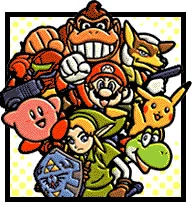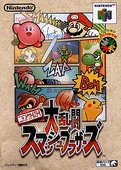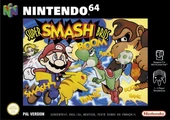- For the article about the series, please see "Super Smash Bros. (series)".
Super Smash Bros., known in Japan as Nintendo All-Star! Great Fray Smash Brothers (ニンテンドウオールスター! 大乱闘スマッシュブラザーズ, Nintendō Ōrusutā! Dairantō Sumasshu Burazāzu), and often shortened to "SSB" or "SSB64", is the game that started the Super Smash Bros. game series. It is the predecessor of Super Smash Bros. Melee, and the pre-predecessor to Super Smash Bros. Brawl.
It was released in Japan on January 21, 1999, in North America on April 26, 1999, and in Europe on November 19, 1999. It's playable on Nintendo 64 and the iQue Player and is available on the Wii's Virtual Console. The PAL Virtual Console version was released on June 12th 2009, and the American Virtual Console version was released on December 21, 2009.
Gameplay
The Super Smash Bros. series is a dramatic departure from many fighting games. Instead of winning by depleting an opponent's life bar, Smash Bros players seek to knock opposing characters off the stage. In Super Smash Bros., characters have a damage total, represented by a percentage value, which rises as they take damage and can exceed 100%, but maxes out at 999%. As a character's percentage rises, the character can be knocked progressively farther by an opponent's attacks. To KO an opponent, the player must send that character flying off the edge of the stage, which is not an enclosed arena but rather an area with open boundaries, usually a set of suspended platforms.When a character is knocked off the stage, the character may use jumping moves to (attempt to) return; as some characters' jumps are longer-ranged, they may have an easier time "recovering" than others. Additionally, some characters are heavier than others, making it harder for an opponent to knock them off the edge but likewise harder to recover.
Each character possesses distinctive moves (such as Mario's fireball) as well as various weapons and power-ups which can be used in each stage. These items appear randomly in the form of Beam Swords, Baseball Bats, Fans, Green Shells and Red Shells, and Hammers.
Super Smash Bros.'s play controls are greatly simplified in comparison to other fighting games. While traditional fighting games such as Street Fighter or Tekken require the player to memorize button-input combinations (sometimes lengthy and complicated, and often specific to a character), Smash Bros uses the same one-attack-button, one-control-stick-direction combinations to access all moves for all characters. Characters are not limited to constantly facing their opponent, but may run around freely. Smash Bros. also implements blocking and dodging mechanics. Grabbing and throwing other characters are also possible, allowing for a large variety of ways to attack.
During battles, items related to Nintendo games or merchandise fall onto the game field. These items have purposes ranging from inflicting damage on the opponent to restoring health to the player. Additionally, most stages have a theme relating to a Nintendo franchise or a specific Nintendo game and are interactive to the player. Although the stages are rendered in three dimensions, players can only move on a two-dimensional plane. Not all stages are available immediately; one stage must be "unlocked" by achieving a particular requirement.
Single player
Although the player can choose from five difficulty levels, the game's single-player mode always follows the same series of opponents. This game mode is called Classic Mode in sequels. The player will choose one unlocked character, and battle against a series of characters in a specific order, attempting to defeat them with only a limited amount of lives. If the player loses all of their lives (or runs out of time), they have the option to continue at the cost of a considerable sum of their overall points. Selecting yes cuts their score in half and restarts the battle. Selecting no or not selecting within a ten second countdown will result in a Game Over.
The "Break the Targets" minigame as well as the "Board the Platforms" minigame are two of the remaining single-player games. The objective of the minigames is to break each target or board each platform, respectively. The goal must be achieved without falling off each character-specific stage. The last one is the "Training Mode" section, where the player can choose any of the available characters and to choose the opponent, as well as any stage. When started, a menu can be brought up to gain almost any control, such as slowed game speed, spawning any item, and telling the opponent what to do.
Multiplayer
Up to four people can play in multiplayer mode, which has specific rules predetermined by the players. Stock and timed matches are two of the multiplayer modes of play. This gives each player a certain amount of lives or a selected time limit, before beginning the match. A winner is declared once time runs out, or if all players except one loses
Characters

Official artwork of the default cast of SSB.

The character-selection screen of SSB (all characters unlocked).
There are twelve characters in Super Smash Bros., eight of which are available from the start, and four of which are unlockable.
Starter Characters
Secret characters
Non-Playable Characters
Stages

The stages of Super Smash Bros.
- Peach's Castle
- Congo Jungle
- Hyrule Castle
- Planet Zebes
- Yoshi's Island
- Dream Land
- Sector Z
- Saffron City
Unlockable Stage
Single Player stages
- Break the Targets
- Board the Platforms
- Race to the Finish
- Battlefield
- Final Destination
- Metal Mario's Stage
Non-playable stages
Modes
1-Player
Multi-player
Tournament play
Unlike Melee, Super Smash Bros. never enjoyed a large professional competitive scene, but interest in Super Smash Bros. has been renewed in recent years with the popularity of Melee and Brawl. Players can play Super Smash Bros. online through Kaillera using the Project64k emulator. However, there have been more and more tournaments of Super Smash Bros. recently due to an influx of new players. Most Smash 64 tournaments are paired up with Melee or long events and most (offline) Smash 64 tournaments are located in California, Central Canada, or New Jersey.
Online Play
Although Super Smash Bros. does not feature online play, emulators have the ability to do so. Project64k and Mupen64k are the most used emulators of playing online.
Gallery
Videos
Trivia
- Bowser, Mewtwo, Pit, Meowth, Peach, and King Dedede were originally going to be playable or planned in this game, but were removed due to time constraints (and in Dedede's case, Sakurai was worried about over-representing his own series). However, King Dedede was a background character in Dream Land in this game and Melee as well as a playable character in Brawl. Bowser and Peach were playable in Melee and Brawl, Mewtwo was playable in Melee, and Pit and King Dedede were playable in Brawl, while Meowth was not playable any of the three.
- Also, it was revealed in an interview with Nintendo's president, Satoru Iwata, that Masahiro Sakurai had intended for Final Smashes to be included in the original Super Smash Bros. He claims that he has proof in the form of recorded voices for when characters used their Final Smash. The idea, however, was never actually implemented until Brawl.
- The original Smash Bros. was originally going to be a game called "Dragon King: The Fighting Game" for the SNES which used the Super FX chip, and didn't have any Nintendo characters at all. There was going to be a new game series called Dragon King, which Dragon King the Fighting Game was going to be first in the series.[1]
- The starting eight characters are placed in the order of when they first appeared in their respective titles on the character selection screen, starting with the oldest, Mario and Donkey Kong, and leading to the most recent, Pikachu.
- When a character is chosen, they perform a brief animation in their player's display box below the character-select array. This is the only game in the series to have this feature.
- In the credits, Charles Martinet, the voice of Mario and Luigi, was misspelled as "Charles Martinee".
- In Super Smash Bros. Melee and Super Smash Bros. Brawl, the characters are trophies that have been brought to life, as demonstrated in their intro sequences and continue screens. This is not the case in Super Smash Bros., in which the characters are instead toys that have been brought to life by Master Hand, and the stages are dioramas.
- The Japanese Version lacks the "Congratulations" screen when you complete 1 player mode.
- The Japanese Version also has completely different sound effects for the hitting of the characters, which are much more realistic like those in Super Smash Bros. Melee and Super Smash Bros. Brawl and other arcade fighting games. This may possibly be a censorship done to keep the game more innocent/cartoony and make the E rating.
- The narrator also says "Fox" in a different tone than the Western version, and he says "Battle Royal" instead of "Free-for-all". In the Western versions, the re-recorded voices have a slightly different echo effect than the Japanese originals.
- In the European version of the game, when set to the German Language, the German announcer does not say "Captain Falcon" or "Team Battle" in German.
- Some items (excluding battering items and containers) and all Pokemon are actually 2D sprites.
- It's absolutely impossible (without hacking) to clear all the eight digits on the counter that tells how many points the player has earned in 1P Mode.
- This is the only game in the series to receive a rating of E for everyone. Its sequels are both rated T for teen.
- This is the only game to exclusively feature Nintendo's heroes. Future installments included playable villains (i.e. Bowser).
- The playable characters are all veterans that return in Super Smash Bros. Melee and Super Smash Bros. Brawl.
- The Mario and Pokemon universe are the only universes to have more than one playable character in this game.
- In the Japanese version, Mario and Luigi have slightly larger heads than in any other version.
- Samus is the only female character. It is unknown whether Pikachu and Jigglypuff are male or female. The other nine characters are all male, including: Mario, Yoshi, Link, Donkey Kong, Kirby, Fox, Luigi, Captain Falcon, and Ness.
External links
| |||||



